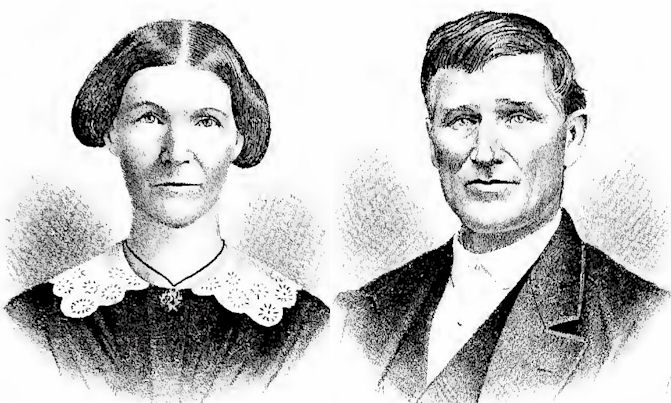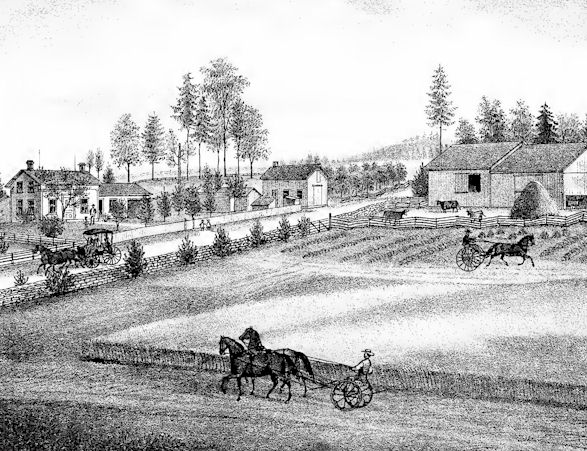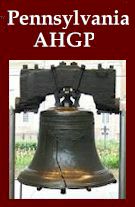Asylum Township, Bradford County, Pennsylvania
Origin of Name
The name of Asylum was given to this town by the French refugees
from the revolution of 1798, who settled herein, as more fully
set forth in the general history of the county.
It is situated on a bend of the Susquehanna, which sweeps to the
northeast, then gracefully curves back and forth, and finally
sweeps back again to the southeast to the same general course
pursued by it through the county. The township lies between the
townships of Towanda and Monroe on the west, Albany on the
southwest, and Terry on the south, the river forming the
boundary on the north and east, between it and the townships of
Wysox, Standing Stone, and Wyalusing.
Settlement
Stephen Durell located at the mouth of the
creek since named in his honor, Durell creek, in 1789 or 1790,
and built a house and saw-mill there. He was said to be a
"quiet, steady, and respectable man," and somewhat advanced in
years, when he came. In 1788 he was ensign in the "Wyalusink"
company of the upper battalion of Luzerne County militia. He was
probably from Connecticut.*
In the fall of 1782, Benjamin Ackla,
Richard Benjamin, and Amos Bennett
came to what was afterwards called Bennett's creek and built
some log houses, and in the spring following moved their
families in from Wyalusing, where they had been living for some
time previously. They were originally from Florida, near Goshen,
in Orange County, New York.
Amos
Bennett and family
Richard Benjamin lived where H. L. Haight now lives. His
children were Jonathan, John, Patty, Polly, Peter, David, Jesse,
Sally, Hetty, Betsey, and Joshua, besides two who died in
infancy. Jonathan married Leah, daughter of Benjamin Ackla, and
lived on the Seeley hill, and died Feb. 1, 1847, aged
seventy-seven years. The property is now owned by William
Storrs. They reared eleven children, all of whom, with their
mother, were living, July 30, 1874, in the neighborhood. John
married Patty Vincent, and, for his second wife, Hannah
(Johnson), widow of his brother David. He lived where his son
Harry lived in 1873. Of eleven children of his but two survive.
Patty married Amos Vargison, and Polly married Samuel Chilson.
Benjamin and Hannah Ackla reared eleven children, Betsey, Amos,
John, Anna, Leah, Phebe, William, Jonathan, Polly, Benjamin, and
David. Mr. Ackla died April 26, 1835, aged eighty-two years.
Deacon Reuben Wells and a Mr. Shaw came to the Gilbert place at
an early day and planted a piece of corn, stayed until it was
grown and hoed, and then went back to Connecticut for their
families. Their bill of fare was a meager one, fish being the
only article, and that served without salt. They varied this,
however, on Sundays by swimming the river and partaking, at Mr.
Fitzgerald's, of what buttermilk and mush they could stow away.
They lived in a log house near the spring, a few rods below the
present residence of Richard Gilbert. Deacon Wells afterwards
went to Wyalusing, and subsequently to Bridgewater, Susquehanna
County.
Samuel Gilbert came from Colchester, Connecticut, about 1790, and
lived a year or two at Kingston, and then moved to the farm now
occupied by Richard Gilbert. Here he rented a piece of land of
the French, who were just beginning their settlement, and he
afterwards bought the farm of the Asylum Company. The usual
hardships of the pioneers were considerably mitigated by the
appliances of comfort of the neighboring French. Samuel Gilbert
was born March, 1742, and died Oct. 12, 1813. He married Mary
Dodge, June 12, 1769. She was born Sept. 20, 1749, and died Jan.
7, 1833. Their children were Lydia, Irene, Hannah, Eunice Anne,
Fanny, Daniel, Samuel, Jr., and Oliver.
Charles Homet emigrated from France to America in January, 1793,
and settled in Asylum in 1796. He was one of the French families
who remained in Bradford, and did not return after the
restoration in his native land. He died Dec. 29, 1838, in the
seventieth year of his age. His wife, Theresa (Schillinger),
preceded him, January 3, 1823, aged sixty-three years. She was a
native of Strasbourg, France. Their children were Charles
Frederick, Francis Xavier, Harriet, and Joseph. Mr, Homet
married his second wife Cynthia Sickler, in 1827, by whom he had
one daughter, the wife of E. T. Fox, of Towanda.
Anthony Vander Pool* *came from Kinderhook, Columbia County, New
York, about 1790, to Bradford County. He was the ancestor of the
large family of that name now in Bradford. His first
stopping-place was Aquaga, where he remained a year or two and
then came to Durell's creek, and from thence moved into the
French settlement and engaged in the employ of that colony. He
built a small log mill on Fowler creek and lived there four or
five years, but, being despoiled of the title to his land,
removed to Wyalusing, and after a short time moved to the hill
near Moody's pond, where he died, aged ninety-nine years, in the
spring of 1838, and was buried on Ellis hill. Martin Van Buren
married a niece of Mr. Vander Pool, the daughter of a brother in
Kinderhook. Abraham Vander Pool, now a resident of Bradford
County, is a son of Anthony Vander Pool, and from him the above
facts concerning his father were obtained.
Anthony Vander Pool's children were William, Anthony, Richard,
Mary, Peter, Samuel, Vina, Abraham, Henry, Catherine, and
Eleanor or "Lane," nearly all of whom are dead.
Isaac Wheeler came into Asylum along with Anthony Vander Pool.
He was also from Kinderhook, and was a drummer in the
Revolution. He was an intelligent, active, hard-working
mechanic, but unfortunately was addicted to drink, and never
accumulated property. His mechanical genius, expended on the
manufacture of spinning-wheels, chairs, etc., and his pension,
supplied his few wants. He moved to Indiana in February, 1822,
where he died. He married Eleanor Johnson, and their children
were Mary (Mrs. Abraham Vander Pool), Kate, Peggy, Margaret,
Nicholas, Samuel, and Richard. None of these are now living in
Bradford County.
Nicholas Johnson, a brother of Isaac Wheeler's wife, came also
from Kinderhook, sometime between 1797 and 1800, but located at
first at Towanda, where he lived for several years, and then
settled in Asylum, and finally removed to Ohio, 1832-33. About
two years after Nicholas Johnson came into the county his
brother Richard also came, but never gained any permanent
location, and, with his wife, is buried at Frenchtown.
Richard Wheeler, a brother of Isaac Wheeler, also came about the
time the Johnsons did, but returned to New York, and finally
came back again, and died here. Ambrose Vincent, who married a
sister of Mrs. Isaac Wheeler, came in 1804-6. He was killed at Wysox, in 1822 or 1823, by the caving in of a well. His only
son, William, married Mary Cornelius.
Henry Cornelius married another sister of Mrs. Wheeler, was a
Revolutionary pensioner, and came into the county soon after the
Johnsons. He died on the mountain below Towanda, on a little
farm he bought there.
Samuel Seeley was a Revolutionary soldier. He came to the
Connecticut grant before the war. After the war he came back to
look after his family, but could not find them. Thinking they
were killed, or had died, he went back to Goshen, New York, from
whence he originally came, where he married Miss Deborah
Benjamin, a sister of Richard Benjamin, and in 1802 came to
Wyalusing creek, where he lived a few years, and then removed to
the Herrick place, where he remained some seventeen or eighteen
years, and then removed to the State of New York, where he
resided twenty-one years. While there he instituted measures to
secure a pension, and going to Crawford County, Pennsylvania, to
get the certificate of the captain of the company in which he
served in the war, he found, much to his surprise and pleasure,
the prothonotary of that county to be the husband of his
daughter, born just after he was drafted into the army. His
remaining children (he had three at the time he was drafted)
were living in that vicinity. From them he learned his family
had been driven off by the Indians, and everything in their
neighborhood had been destroyed. In 1827 he came back for a
short time to where Keizer now lives. In 1815 he built a
saw-mill near Myron Frisbie's, but ere it was finished
Hollenback served an ejectment on him, and he abandoned the
place. He died in 1840, at the age of eighty-eight years.

Mary and Robert Bull (not mentioned in text)

Robert Bull Farm (not mentioned in text)
The Chilson family were early settlers in the town, and were
also from Florida, New York Samuel and Albert were the heads of
the family, but Albert, after two or three years, moved west.
Samuel Chilson lived on the Ackla place, and died February,
1846, at the age of eighty-five years. Samuel Chilson (2nd),
Jehiel, and Joel, nephews of the elder Samuel, came to the
county about 1811, a brother, Asa, coming in 1809. Robert,
George, Anson, and William were also brothers. Robert came in
1814, and Anson soon after the War of 1812 had closed, he
serving therein. After some seven years he removed to
Horseheads, New York, where he passed the remainder of his life.
Robert lived and died on the farm now occupied by his son
Benjamin, his death occurring about 1860. William came in 1813;
removed to Smithfield, where he died. He lived with his brother
Samuel in Asylum a number of years. Asa, after some twelve
years, returned to Florida, where he died from an injury
received in sharpening a scythe, terminating in lockjaw. Samuel
Chilson (2nd) died at Frenchtown.
Nathan Bailey, Harry Ellsworth,
John Stringer, and Joseph H.
Ellis were all among the early settlers.
Macedonia
Schools
About 1798 a log school-house was built on the ridge below
Israel Smith's, and the first school taught here was presided
over by a son of the Emerald Isle, named William McCarty. The
returns of the school year ending June 1, 1877, give the
following exhibit of the status of educational privileges in the
town of the present: seven schools were taught, averaging five
months each; three male and four female teachers were employed,
the gentlemen receiving an average of $24.75 per month, and the
ladies 115.04 salary; 167 boys and 120 girls attended the
schools. Five mills were levied on the dollar for school
purposes, and one mill for building purposes, the tax amounting
to $854.97. The amount received from the State was $219.85.
Teachers' wages amounted to $745.64, and other expenditures to
$233.36.
Reminiscence
Amos Bennett and family were at Wyoming at the time of the
Indian attack, and were living there in a log house. During the
progress of the battle, a party of Indians came near and were
discovered. Prudie, out of curiosity, opened the door, but was
instantly- pulled back into the house, and the door reclosed.
Scarcely had the inquisitive girl been dragged into the house,
when a bullet struck in the doorpost, where she had stood a
moment before.
One of the Frenchmen at Asylum committed suicide. Mrs. Abraham
Vanderpool relates that about eleven o'clock one night (when she
was a little girl) the family heard someone scream, but it being
heard but once, no notice was taken of it. The next morning some
of the Negroes came to inquire about their master, and her
father (Isaac Wheeler) went with them, and soon found him
sitting on the ground, with a handkerchief tied about his neck,
and the corner of it to a bush, the spring of which had choked
him to death. He had lost some money, and on account thereof
became insane.
A Macedonian Cry
The name of Macedonia was given to the Cole settlement by reason
of a sermon preached by Amos Akla, in which the words
"Macedonia," "Macedonian cry,'' "Come over and help us,'' etc.,
were used very freely. The boys took up the phrases, and called
the settlement Macedonia, a cognomen which has ever since clung
to that part of the town.
Population
In 1850 Asylum contained 820 souls, eleven of them being
colored. In 1860 there were 1241, and in 1870, 1155. Of these,
47 were foreign born, and 60 were colored.
Footnotes:
*In the history of New London, Connecticut, it is said that
Capt. Philip Durell commanded the British
ship-of-war "Cygnet," cruising off New London, at which point
she arrived January 11, 1764, and that this officer was the best
known to the inhabitants.
** The old records of Columbia County, New York, spell this name
Vander Poel.
Pennsylvania AHGP |
Bradford County

|




![]()

